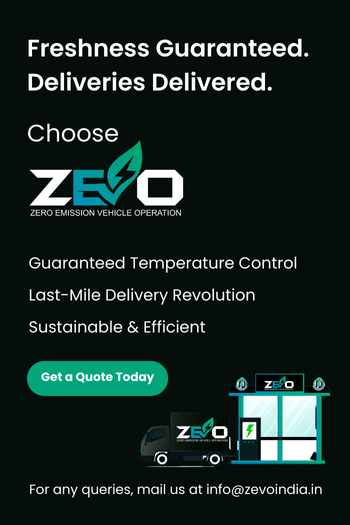Refrigerated Last-Mile Delivery: The Secret to Freshness (And How You Can Achieve It)

Akshay Sharma
CEO's Office @ZEVO
The global food waste problem is alarming. The Food and Agriculture Organization (FAO) estimates that around 14% of food spoilage occurs during transportation and storage
[Source: FAO].
This issue becomes even more critical in India, where the online grocery market is booming, expected to generate a revenue of INR US$30.65 billion by 2024
Imagine the impact on your business in this rapidly growing market – lost revenue, frustrated customers, and potential health risks from improper temperature control.
This is where refrigerated last-mile delivery steps in. It’s the key to ensuring your perishable products, from groceries to medicine, arrive fresh, safe, and ready to use.
This blog post will explore how refrigerated last-mile delivery can help businesses like yours:
- Minimize spoilage and the financial losses associated with it.
- Enhance customer satisfaction by delivering fresh, high-quality products.
Gain a competitive edge with efficient cold chain logistics.
Understanding the Need for Refrigerated Last-Mile Delivery
Products Affected: Not all deliveries require the specialized care of refrigerated last-mile services. However, several industries rely heavily on maintaining consistent temperatures to ensure product safety, quality, and effectiveness.
Here’s a breakdown of some key categories:
Food and Beverage:
This is the most prominent industry for refrigerated last-mile delivery. It encompasses a wide range of products, each with specific temperature requirements:
- Meat, poultry, and seafood: These products require consistent cold temperatures (typically between 0°C and 4°C) to prevent spoilage and bacterial growth.
- Dairy products: Milk, cheese, and yogurt need cool temperatures (around 4°C) to maintain freshness and prevent spoilage.
- Fruits and vegetables: While some fruits and vegetables have longer shelf lives at room temperature, others benefit from cool storage (around 7°C to 13°C) to extend their freshness and quality.
Prepared meals and baked goods: Items like pre-made salads or cooked meals require refrigeration (around 4°C) to maintain safety and prevent bacterial growth.
Pharmaceuticals and Medical Supplies:
This industry deals with temperature-sensitive medications, vaccines, and biological samples. Maintaining proper temperatures (ranging from freezing to room temperature) is crucial for ensuring the effectiveness and safety of these products:
- Vaccines: Many vaccines require extremely cold storage (around -70°C) to maintain their efficacy.
- Insulin and other injectable medications: These medications often need cool storage (around 2°C to 8°C) to remain effective.
- Blood and blood products: These require very specific temperature ranges depending on the type (typically between 2°C and 6°C) to prevent spoilage and ensure safe transfusions.
Why Last-Mile Delivery is Critical?
The last-mile delivery stage is often the most vulnerable point in the cold chain. Here’s why:
- Frequent Stops and Shorter Durations: Unlike long-haul transportation with dedicated refrigerated containers, last-mile delivery involves frequent stops and shorter trips. This increases the risk of temperature fluctuations if proper precautions aren’t taken.
- Door-Opening Times: Frequent opening and closing of delivery vehicles can cause temperature spikes, especially in hot climates.
- Consumer Expectations: Modern consumers expect fresh, high-quality products delivered straight to their doorsteps. Refrigerated last-mile delivery ensures these products arrive safely within the required temperature range.
By implementing effective refrigerated last-mile solutions, you can:
- Uphold the integrity of your temperature-sensitive products throughout the entire supply chain.
- Reduce spoilage costs and eliminate the financial losses associated with wasted inventory.
- Boost customer satisfaction by delivering fresh, high-quality products that arrive safely.
Maintaining Freshness: Technologies and Strategies
The key to successful refrigerated last-mile delivery lies in maintaining consistent temperatures throughout the journey.
Temperature Control Methods:
1. Refrigerated Trucks and Vans: These are equipped with powerful refrigeration units that can maintain consistent cool temperatures (typically between -18°C and 4°C) throughout the delivery route.
Ideal for large quantities of temperature-sensitive products like meat, seafood, and frozen meals.
2. Insulated Packaging Materials: These offer a versatile and cost-effective solution for shorter deliveries.
Here’s a breakdown of some common types:
- Coolers and Thermal Boxes: These rigid containers utilize insulation materials like polystyrene or polyurethane to slow down heat transfer.
They can be used with gel packs or Phase Change Materials (PCM) for additional temperature control. PCM absorbs or releases heat as they change phases (solid to liquid or vice versa), helping maintain a specific temperature range. - Insulated Envelopes and Liners: These lightweight options are ideal for smaller, temperature-sensitive items. They are often made with reflective materials that help deflect heat and can be used with gel packs for added control.
- Dry Ice: For products requiring extremely low temperatures (around -70°C), dry ice sublimation can provide a temporary solution. However, proper ventilation is crucial to avoid suffocation hazards.
Dry ice should only be handled with proper training and used with caution. - DC Batteries: Delivery vehicles can be equipped with secondary DC battery systems to power refrigeration units independently of the main engine.
This minimizes temperature fluctuations during stops and engine restarts, especially important for frequent deliveries in urban areas.
Temperature Monitoring Devices:
Real-time temperature trackers are invaluable tools in your refrigerated last-mile delivery arsenal. These small devices are placed inside packages and transmit temperature data wirelessly.
You can monitor the internal temperature of your packages throughout the delivery process, allowing for quick intervention if any deviations occur from the desired range. These trackers provide peace of mind and ensure you can maintain the integrity of your products.
Optimizing Delivery Routes:
- Route Planning Software: Utilize software that factors in traffic patterns, weather conditions, and the number of stops to create efficient delivery routes. This minimizes travel time and ensures products spend less time exposed to ambient temperatures.
- Delivery Consolidation: Plan your deliveries strategically to minimize the number of stops and consolidate orders in the same temperature range whenever possible. This reduces door-opening frequency and maintains consistent temperatures within the vehicle.
- Pre-cooling Products: Pre-chill your products to their optimal temperature before they even hit the delivery vehicle. This minimizes the time it takes to reach the desired temperature inside the packaging or refrigerated truck.
The Future is Fresh: Delivering on Cold Chain Excellence
Refrigerated last-mile delivery isn’t just about keeping things cold; it’s about protecting your business and delighting your customers. By implementing these strategies and staying informed about emerging technologies like self-cooling containers and smart packaging, you can ensure a future where freshness is guaranteed, spoilage is minimized, and customer satisfaction soars.
Take control of your cold chain and unlock the full potential of refrigerated last-mile delivery. Your customers, and your bottom line, will thank you for it.

Share this Article
Subscribe to our newsletter
Be the first to receive exclusive offers and the latest news on our products and services directly in your inbox.
